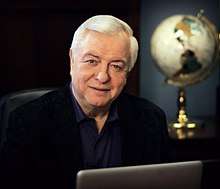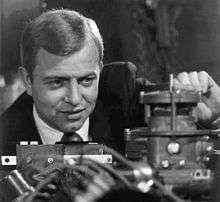Roger E. Billings
Roger Billings is a scientist known for his high-tech innovations in the fields of energy, computer networking, cybersecurity, and education. As a student in high school, he invented the hydrogen car.[1]
Roger Billings | |
|---|---|
 | |
| Born | January 1948 |
| Nationality | American |
| Alma mater | Institute of Science and Technology |
| Known for | Hydrogen Car, Acellus Learning System, GoldKey Security, WideBand Networking |
| Awards | Gold and Silver Award - International Science Fair Ten Outstanding Young Men - US Jaycees |
| Scientific career | |
| Fields | Hydrogen energy |
| Influences | Bill Lear, Sir Geoffrey Pardoe, Willis Hawkins, John K. Hansen, Bill Gates |
Billings is the creator of the Acellus Learning System, which has been described as a scholastic "equalizer" for students that are falling behind academically.[2]
Billings is also the CEO and Chairman of Billings Energy Corporation, a company focused on the development of hydrogen energy technologies. The company is headquartered in Kansas City, Missouri. The company plans to build upon privately funded research and development efforts conducted over the past ten years to bring to market commercial hydrogen energy applications.
Billings is the author of two books on hydrogen energy technology, Hydrogen from Coal: A Cost Estimation Guidebook (1983) and Hydrogen World View (1991), and the co-author of a technical networking book, WideBand Networking (2000). He has also authored numerous technical papers on hydrogen energy and on computer networking, including reports on his nano-latency data transfer research and development projects in conjunction with the US military, published in the SPIE conference proceedings.[3]
Education

Billings entered school and regional Science Fairs for each of the three years of high school. He tied for first place for his project on treating seeds with high frequency sound waves the first year, he took second place for his voice-controlled amplifier for laser communications the second year, and he achieved first place as a high school senior for his hydrogen-burning automobile.[4]
He earned his Bachelor of Science degree in 1974 with a composite major in physics, chemistry, electrical, mechanical, and chemical engineering. During his university studies, Billings was selected by Bill Lear, the creator of the Lear Jet, to be his protégé. Lear moved Billings and his young family to Reno, Nevada, where, for nearly a year Lear mentored Billings in high-tech entrepreneurship.[5]
On June 9, 1988, Billings received his Doctor of Research Degree from the American Academy of Science, which was later known as Institute of Science and Technology. He later completed post-doctoral studies at MIT in Applied Cybersecurity.
Hydrogen energy
Billings generated interest in hydrogen technology by demonstrating a number of working prototypes, including cars, buses, forklifts, tractors, and a hydrogen-powered home.[6]
In 1971, as an undergraduate student, Billings received a research grant from the Ford Motor Company and his own lab to continue his studies of the hydrogen-fueled automobile.[7] In the summer of 1972, Billings headed a university team that won first prize for low emissions at the Urban Vehicle Design Competition held at the General Motors Proving Grounds in Ann Arbor, Michigan. Their winning entry was a hydrogen powered Volkswagen.
Billings established his own company Billings Energy Research Corp in 1972,[8] The company converted 18 vehicles of various types to run on hydrogen.
In 1975, Billings and his team built the “Hydrogen Homestead” prototype, a home which included hydrogen-run heat pump, water heater, oven, range, fireplace log, outdoor grill, a car and tractor. The Homestead project resulted in the development of some innovative hydrogen applications and demonstrated that hydrogen was compatible with existing home appliances. Originally part of the Hydrogen Homestead Project, the hydrogen-fueled Cadillac Seville featured a dual-fuel system, hydrogen and gasoline, which could be switched back and forth. This made the vehicle practical for everyday use at a time when hydrogen availability was not abundant. Its improved metal hydride storage system operated at a lower temperature than previous units, allowing a cost saving on construction material. The Cadillac was featured in the 1977 inaugural parade for President Jimmy Carter.
After converting family car-sized vehicles to run on hydrogen, Billings turned to larger means of transportation. Billings’ hydrogen powered buses – converted to hydrogen first in 1976 and running in Provo, Utah, then in Riverside, California – were successful demonstrations of hydrogen as a fuel for mass transit vehicles. The Postal Jeep project in 1977 demonstrated the potential use of hydrogen as a practical and advantageous fuel for fleet vehicles. By 1979, he was working on coal-to-gas conversion plants.[9]
In 1991 Billings built the first automobile to be powered by a hydrogen fuel cell.[10] Billings later demonstrated this innovation in the practical development of hydrogen as a fuel for use in cars. The Philadelphia unveiling of the car — LaserCel 1 — is the first reported functional fuel cell application in a small transportation vehicle.
Billings was touted in the press for his contributions in developing hydrogen energy. The Enterprise business journal called Billings “The Father of Hydrogen Technology.”[11] An Omni Magazine report on his work in 1982 dubbed him “The Hydrogen Man"[6] and an article in the July 21, 2003, issue of Time Magazine referred to him as "Dr. Hydrogen".[10]
Computer networking
Billings has been involved in the development and launch of a number of computer technologies and products.
He established the Billings Computer Corporation in 1977, which manufactured one of the first Personal Computers, the Billings Computer. The same year, Billings Computer Corporation paid the New Mexico start-up company, Microsoft, $340,000 to acquire usage rights for EBasic and to fund the development of Fortran and Cobol compilers. In 1982 Time Magazine featured a photo of the young Bill Gates in his office with the Billings Computer on his desk.[12]
In 1978, Billings Computer Corporation hired Alan Ashton to help develop the Billings Word Processor, an award-winning program offered for the Billings MicroSystem, which provided a user friendly and intuitive interface. After the launch of the IBM PC in 1981, Alan Ashton released an enhanced word processor called Word Perfect.
Later, Billings founded Caldisk, Inc., which was instrumental in the development of the "double-sided floppy drive." Caldisk was later acquired by World Computer Corporation.
Billings invented a method of sharing data on a computer network known as Functionally Structured Distribution (FSD). This method was the forerunner of today’s client-server computing.[13] It is one of the enabling technologies of the Internet.[1]
Ventures
In 1985, Billings sold the Billings Energy Corporation and joined with Dr. Geoffrey K. Pardoe, Chairman, General Technology Systems in London; Dr. Alexei A. Tupolev of the Tupolev Design Bureau in Moscow; Willis Hawkins, President of Lockheed Corporation in California; and Olof Tegström, Founder and President of Tebetron in Sweden, to establish the "International Academy of Science", a not-for-profit organization for the advancement of applied science and scientific education. The International Academy of Science (Academy) operates the International Institute of Science and Technology—a Graduate School University that offers the Doctor of Research and Master of Research Degrees.
The International Academy of Science is host to the Science Information System (SIS), an Internet-accessible repository of scientific information, which includes three major components: the Scientific Community Registry, the Encyclopedia of Science and Technology, and the Journal of Science. The Journal of Science is a peer-reviewed, electronic publication forum that allows members of the scientific community to expeditiously publish reports of their research.
In 1994, Roger Billings founded the WideBand Corporation, one of the first companies to develop a gigabit data rate networking product. WideBand came up with a pre-standard design that could operate over standard Category 5 cable. Later, when IEEE established the 802.3ab workgroup to create a gigabit data rate networking standard, Billings served as a member of the Steering Committee of the Ethernet Alliance and also contributed technical presentations in the development of the standard. WideBand Corporation began to manufacture a standards-based Gigabit Ethernet product that could operate over conventional cabling, instead of requiring users to rewire their premises to Category 5e or better cable.
Billings established fs[ix] Corporation in 1995 to manufacture a commercial line of computer storage products based on the fs[ix] network operating system. fs[ix] Servers ship with the software pre-installed, which allows them to be tuned for specific hardware installations, increasing storage and retrieval performance. fs[ix] Servers are primarily used to handle large data storage needs such as Hollywood animations, military applications, and substantial library projects.
References
- CTR Editors (April 20, 2015). "Spotlight on: Dr. Roger Billings, Science and Technology Luminary". Computer Technology Review.
- Williams, Mara (March 27, 2018). "Online, interactive learning system called a "game changer" in preventing dropouts". The Kansas City Star. Retrieved 2018-04-01.
- Kim, Hajin (May 11, 2012). "Common hardware-in-the-loop framework development". Proceedings of SPIE. 8356 Technologies for Synthetic Environments: Hardware-in-the-Loop XVII 83560O. doi:10.1117/12.885648.
- Perry, Leo (April 27, 1966). "Youth's Hydrogen Motor Wins Trip to Dallas". Deseret News. Retrieved 2010-03-23.
- Tepper, Ron (January 1982). "Young Millionaire of the Month". Entrepreneur Magazine.
- Rose, Kenneth Jon (January 1982) Omni (magazine)
- "Student inventor granted funds", The Daily Universe, June 22, 1971
- "Farewell, Billings Energy", The Daily Herald, October 3, 1979
- "Hydrogen, Another Solution to the Energy Crunch", Mother Earth News (Mar/Apr, 1979)
- Barlett, Donald and Steele, James (Jul. 14, 2003), "Hydrogen is in his Dreams", Time Magazine
- Bentley, Alene E. (Aug. 19, 1975), The Enterprise
- Time Magazine, June 7, 2007, retrieved 2010-03-28
- Patent, Billings, Roger E., "Functionally structured distributed data processing system", issued 1986-10-20